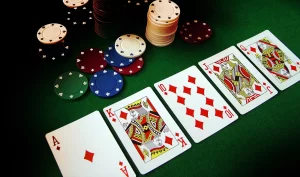How to Master Poker Tells and Body Language

Nonverbal cues such as body movements and facial expressions convey information about your opponents’ hands that cannot be communicated verbally. Interpreting these tells can provide you with a competitive edge at the poker table.
Recognizing tells requires practice and an accurate eye. To start off, observe your opponent’s baseline profile and observe any outliers during a hand.
Observing Your Opponents’ Body Language
Body language at the poker table can provide you with valuable insight into a player’s confidence level and strength of hand. Tics, eye movements, vocal tone and breathing patterns may all give an indication of whether their hand is weak or strong. Pay particular attention when your opponents need to decide between calling or folding.
Body language analysis to detect your opponent’s strengths and weaknesses can give you a significant edge when playing poker, whether bluffing or for real money. Spotting tells takes practice; to maximize results it is best if you study your opponents across multiple games and tables; additionally learning how to conceal your own body language can also be very useful; one way of doing this would be developing a consistent routine at the poker table that prevents more astute opponents from getting an impression of your play style.
Observing Your Opponents’ Gestures
As you play poker, pay attention to your opponents’ movements and body language. Keep an eye out for fidgeting or nervous hands; this could indicate they have a weak hand; conversely if they seem confident despite trembling hands this could indicate they have a stronger one; just remember that players often fake tells so the best way to identify the truth is observing their play as well as other factors.
Be mindful when reading players’ cards shuffled and held by others – both how they hold and shuffle can give away much about the strength of their hands, so paying attention to how they shuffle is key for successfully reading opponents’ hands accurately. Furthermore, pay close attention to gestural language used by your opponents, but do not use these tells alone; use in combination with factors like betting patterns and previous gameplay observations for maximum impact. Be sure to vary up your body language and behavior so it will be harder for opponents to pick up on any tells from you as much as possible.
Observing Your Opponents’ Eye Contact
Though some tells may be obvious, others can be less so. For example, players holding strong hands tend to avoid making eye contact and not take unnecessary table actions such as checking cards or restacking chips. They might also speak softly and make decisions more slowly than other players – this type of tell can be hard to detect but once detected correctly can save a significant sum by not calling hands that might otherwise tempt you.
Straighten up and you could have a strong hand! Straightening up can signal that a player is interested in their hand, possibly hinting they may bluff. But take note: microexpressions provide more insight into your opponents emotions and intentions – using body language can give you an edge against opponents, helping you win more pots and increase bankroll!
Observing Your Opponents’ Posture
Poker tells are an invaluable weapon for experienced players, while they’re also something newer players can utilize effectively. Tells are small body language or facial expression cues that give away what kind of hand they hold.
Identification of poker tells starts by watching how your opponents hold their heads, lean back or forward, or fidget. Some tells may go undetected by many players; small changes such as this one could go undetected for long.
Example: When responding to your call, an opponent who straightens their posture could indicate they hold a powerful hand. But if they then grab a drink or fumble with their chips it could indicate that they’re trying to hide their interest by appearing nervous. Therefore it is wise to use this tell alongside other forms of game knowledge such as pot odds and their knowledge of their own hand.







